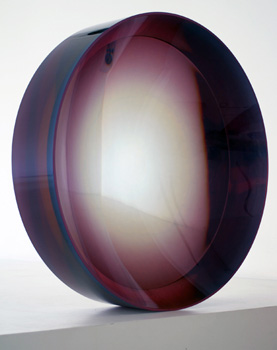
Continuing through October 29, 2011
This four-decade survey of twenty of Fred Eversley's luminous polyester resin sculptures attests to his stature in the Los Angeles art hierarchy. His sculpture will also be on view in two other Pacific Standard Time exhibitions, "Crosscurrents in LA Painting and Sculpture 1950-70" at the Getty Center and "Now Dig This! Art and Black Los Angeles 1960-1980" at the Hammer Museum. Originally an engineer who worked for NASA, Eversley was fascinated with the parabolic form and the optical illusion created by the curve and reflections. A minimalist artist and part of the light and space movement during the late sixties in Los Angeles, he soaked up the transcendent theories and images of Robert Irwin and looked closely at Larry Bell's shimmering, reflective boxes. Living and working in Venice, he absorbed not only the lyrical aspects of the light and space movement, but also the changing nature of perception so ingrained in the work of Irwin, Bell, Dewain Valentine and James Turrell.
His shimmering discs have an exquisite sense of color and space, as in the layers of violet, amber and blue that change as the viewer moves around them. Circles within circles span the space of his sculpture and the glowing colors of blue, yellow and a rich crimson light emanate from the piece. Each hue melts into the other in a subtle play of color and light that enhances the stately beauty of the form. A spectrum of variegated color seems to be encapsulated in the piece. Simple in shape, their parabolic format and translucency suggest the complexities of science and exploration of space, the giant telescopic lenses, the mirrors on satellites, and the actual image of earth distorted from a window of the space shuttle. Although they have no moving parts, his sculptures are considered kinetic because they change so rapidly along with the viewpoint of the spectator.
Even his monochromatic pieces change and flow continually, which stems from centrifugal casting that Eversley uses. Resembling a cast off wheel, one disc is filled with a gold light that changes with each curve and shadow. The clear resin is insubstantial yet has a spatial weight that gives the piece its power. A clear red disc resembles a giant lens that reflects and changes all through its transparent skin, an elegant ode to light. It appears weightless but still manages to convey an austere energy.
Later works become more complex spatially, including a brilliantly crimson ribbon of plastic whose edges are stepped in a continuous sequence. Looking like a staircase to nowhere, this vibrant sculpture moves rhythmically through space. Another red sculpture, this one in a sharp vertical triangular format, continues his incursion into spatial energy and light, with multiple reflections changing the surface. Another wedge sculpture consolidates his luminous palette of colors as shimmering, delicate, constantly mixing and separating colors of violet, gold, tangerine and deep purple that overlap in geometric shapes.
Spare and reductive, Eversley’s sculptures have an inherent mysticism that emerges from the vagaries of light and color. With each changing shadow the sculptures are transformed anew, waiting for the next shifting of light to begin again.
Published courtesy of ArtSceneCal ©2011
